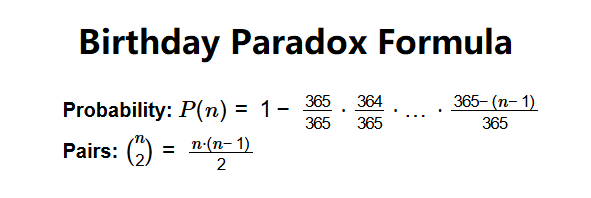1. What is a Birthday Paradox Calculator?
Definition: This calculator computes the probability that at least two people in a group of \( n \) share the same birthday and the number of possible pairs in the group. The birthday paradox shows that a 50% chance of a shared birthday occurs with just 23 people, due to the number of possible pairs.
Purpose: It illustrates probability concepts in statistics, with applications in cryptography (e.g., birthday attacks) and analyzing coincidences in datasets.
2. How Does the Calculator Work?
The calculator uses these formulas:
- Probability: \( P(n) = 1 - \frac{365}{365} \cdot \frac{364}{365} \cdot \ldots \cdot \frac{365 - (n-1)}{365} \)
- Pairs: \( \binom{n}{2} = \frac{n \cdot (n-1)}{2} \)
- Where:
- \( n \): Number of people.
- \( P(n) \): Probability of at least two sharing a birthday.
- \( \binom{n}{2} \): Number of possible pairs.
- Leap years: Uses 365.25 days instead of 365.
Steps:
- Input number of people (\( n \)).
- Select leap year option (365 or 365.25 days).
- Validate: \( n \) must be an integer between 1 and 1000.
- Calculate probability of no shared birthdays: \( \frac{365}{365} \cdot \frac{364}{365} \cdot \ldots \cdot \frac{365 - (n-1)}{365} \).
- Compute \( P(n) = 1 - \text{no shared probability} \).
- Compute pairs: \( \frac{n \cdot (n-1)}{2} \).
- Display probability (%) to 2 decimal places and pairs as an integer.
3. Importance of Birthday Paradox Calculations
These calculations are key for:
- Statistics Education: Demonstrates surprising probability outcomes.
- Cryptography: Informs birthday attack strategies for hash collisions.
- Data Analysis: Estimates coincidence probabilities in large groups.
4. Using the Calculator
Example:
- Group of 5 people, no leap years:
- Probability: \( P(\text{no match}) = \frac{365}{365} \cdot \frac{364}{365} \cdot \frac{363}{365} \cdot \frac{362}{365} \cdot \frac{361}{365} \approx 0.9729 \).
- \( P(5) = 1 - 0.9729 \approx 0.0271 \approx 2.71\% \).
- Pairs: \( \binom{5}{2} = \frac{5 \cdot 4}{2} = 10 \).
- Result: 2.71% chance of at least two sharing a birthday, 10 possible pairs.
5. Frequently Asked Questions (FAQ)
Q: Why is the birthday paradox surprising?
A: A 50% chance of a shared birthday occurs with only 23 people, far fewer than expected.
Q: Why calculate the number of pairs?
A: It shows why the probability grows quickly, as pairs increase quadratically with \( n \).
Q: How do leap years affect the result?
A: Using 365.25 days slightly increases the probability, requiring 367 people for 100% certainty.
 Home
Home
 Back
Back
